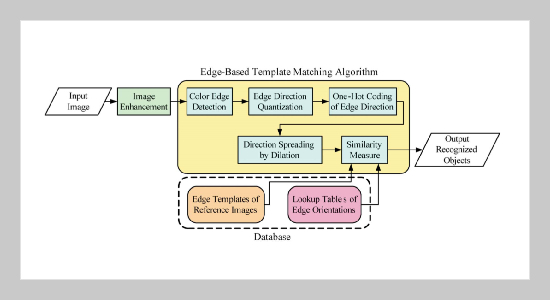REFERENCES
- [1] Lowe, D. G., “Distinctive Image Features from Scale in variant Key points,” International Journal of Computer Vision, Vol. 60, No. 2, pp. 91�110 (2004). doi: 10.1023/B:VISI.0000029664.99615.94
- [2] Bay, H., Tuytelaars, T. and Gool, L. V., “SURF: Speeded Up Robust Features,” Computer Vision and Image Understanding, Vol. 110, No. 3, pp. 346�359 (2008). doi: 10.1016/j.cviu.2007.09.014
- [3] Rublee, E., Rabaud, V., Konolige, K. and Bradski, G., “ORB: an Efficient Alternative to SIFT or SURF,” IEEE International Conference on Computer Vision, Colorado Springs, USA, Jun. 20�25, pp. 2564�2571 (2011). doi: 10.1109/ICCV.2011.6126544
- [4] Costa, M. S. and Shapiro, L. G., “3D Object Recognition and Pose with RelationalIndexing,” Computer Vision and Image Understanding, Vol. 79, No. 3, pp. 364�407 (2000). doi: 10.1006/cviu.2000.0865
- [5] Weiss, I. and Ray, M., “Model-based Recognition of 3D Objects from Single Images,” IEEE Transactions on Pattern Analysis and Machine Intelligence, Vol. 23, No. 2, pp. 116�128 (2001). doi: 10.1109/34.908963
- [6] David, P. and DeMenthon, D., “Object Recognition in High Clutter Images Using Line Features,” IEEE International Conference on Computer Vision, Beijing, China, Oct. 15�21, pp. 1581�1588 (2005). doi: 10. 1109/ICCV.2005.173
- [7] Schiffenbauer, R. D., “A Survey of Aspect Graphs,” Department of Computer and Information Science, Polytechnic University, Technical Report TR-CIS2001-01, Brooklyn, New York (2001).
- [8] Cyr, C. M. and Kimia, B. B., “A Similarity-based Aspect-graph Approach to 3D Object Recognition,” International Journal of Computer Vision, Vol. 57, No. 1, pp. 5�22 (2004).
- [9] Eggert, D. W., Bowyer, K. W., Dyer, C. R., Christensen, H. I. and Goldgof, D. B., “The Scale Space Aspect Graph,” IEEE Transactions on Pattern Analysis and Machine Intelligence, Vol. 15, No. 11, pp. 1114� 1130 (1993). doi: 10.1109/34.244674
- [10] Ulrich, M., Wiedemann, C. and Steger, C., “Combining Scale-space and Similarity-based Aspect Graphs for Fast 3D Object Recognition,” IEEE Transactions on Pattern Analysis and Machine Intelligence, Vol. 34, No. 10, pp. 1902�1914 (2012). doi: 10.1109/TPAMI. 2011.266
- [11] Steger, C., “Occlusion, Clutter, and Illumination Invariant Object Recognition,” International Archives of the Photogrammetry, Remote Sensing, Vol. 34, Part 3A, pp. 345�350 (2002).
- [12] Hinterstoisser, S., Lepetit, V., Ilic, S. and Fua, P., “Dominant Orientation Templates for Real-time Detection of Texture-less Objects,” IEEE Conference on Computer Vision and Pattern Recognition, San Francisco, USA, Jun. 13�18, pp. 2257�2264 (2010). doi: 10. 1109/CVPR.2010.5539908
- [13] Hinterstoisser, S., Cagniart, C., Ilic, S., Sturm, P., Navab, N., Fua, P. and Lepetit, V., “Gradient Response Maps for Real-time Detection of Textureless Objects,” IEEE Transactions on Pattern Analysis and Machine Intelligence, Vol. 34, No. 5, pp. 876�888 (2012). doi:10.1109/TPAMI.2011.206
- [14] Hinterstoisser, S., Holzer, S. and Cagniart, C., “Multimodal Templates for Real-time Detection of Textureless Objects in Heavily Cluttered Scenes,” IEEE International Conference on Computer Vision, Barcelona, Spain, Nov. 6�13, pp. 858�865 (2011). doi: 10.1109/ ICCV.2011.6126326
- [15] Cai, H., Werner, T. and Matas, J., “Fast Detection of Multiple Textureless 3-D Objects,” International Conference on Computer Vision Systems, St. Petersburg, Russia, Jul. 16�18, pp. 103�112 (2013). doi: 10.1007/ 978-3-642-39402-7_11
- [16] Tombari, F., Franchi, A. and Di, L., “BOLD Features to Detect Texture-less Objects,” IEEE International Conference on Computer Vision, Sydney, Australia, Dec. 1�8, pp. 1265�1272 (2013). doi: 10.1109/ICCV. 2013.160
- [17] von Gioi, R. G., Jakubowicz, J., Morel, J. M. and Randall, G., “LSD: a Fast Line Segment Detector with a False Detection Control,” IEEE Transactions on PatternAnalysisand Machine Intelligence,Vol.32, No. 4, pp. 722�732 (2010). doi: 10.1109/TPAMI.2008.300
- [18] Chan, J., Lee, J. A. and Qian, K., “BORDER: an Oriented Rectangles Approach to Texture-less Object Recognition,” IEEE Conference on Computer Vision and Pattern Recognition, Las Vegas, USA, Jun. 27�30, pp. 2855�2863 (2016). doi: 10.1109/CVPR.2016.312
- [19] Chan, J., Lee, J. A. and Qian, K., “BIND: Binary Integrated Net Descriptors for Texture-less Object Recognition,” IEEE Conference on Computer Vision and Pattern Recognition, Hawaii, USA, Jul. 21�26, pp. 2068�2076 (2017). doi: 10.1109/CVPR.2017.322
- [20] Tsai, C.-Y. and Huang, C.-H., “Real-time Implementation of an Adaptive Simultaneous Dynamic Range Compression and Local Contrast Enhancement Algorithm on the GPU,” Journal of Real-Time Image Processing, Online Published (2015). doi: 10.1007/ s11554-015-0532-4
- [21] Ali, M. A., Park, H. A. and Lee, C. S. G., “Closed-form Inverse Kinematic Joint Solution for Humanoid Robots,” IEEE/RSJ International Conference on Intelligent Robots and Systems, Taipei, Taiwan, Oct. 18�22, pp. 704-709 (2010). doi: 10.1109/IROS.2010.5649842
- [22] Rogers, D. F. and Adams, J. A., Mathematical Elements for Computer Graphics,2nd Ed., McGraw-Hill, New York, pp. 132�135 (1990).
- [23] Tsai, C.-Y., Yu, C.-J., Yu, C.-C. and Wong, C.-C., “Real-time Implementation of a Key point-based Automatic Target Selection and Tracking Systemfor Applications of Random Bin Picking,” ICIC Express Letters, Part B: Applications, Vol. 7, No. 5, pp. 1135� 1140 (2016).
- [24] Tsai, C.-Y., Wong, C.-C., Yu, C.-J., Liu, C.-C. and Liu, T.-Y.,“A Hybrid Switched Reactive-based Visual ServoControl of 5-dof Robot Manipulators for Pick-and place Tasks,” IEEE Systems Journal, Vol. 9, No. 1, pp. 119�130 (2015). doi: 10.1109/JSYST.2014.2358876 [25] D-textureless dataset on http://vision.deis.unibo.it/ BOLD/dataset/.
















